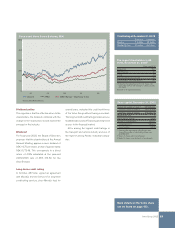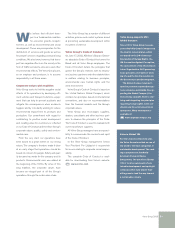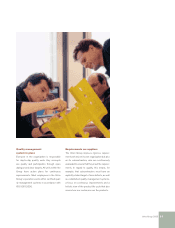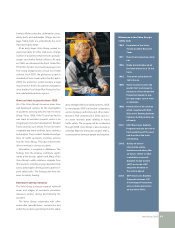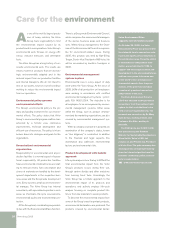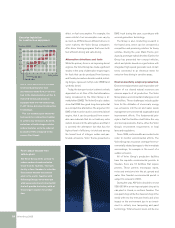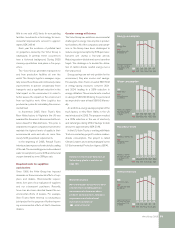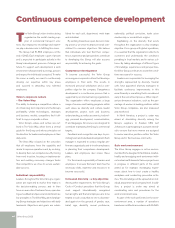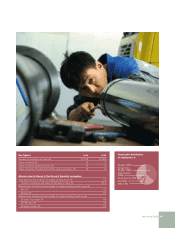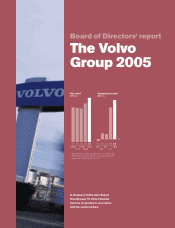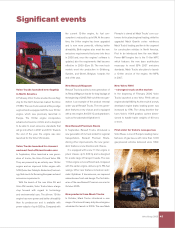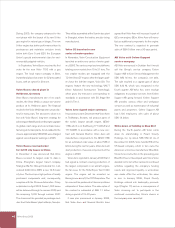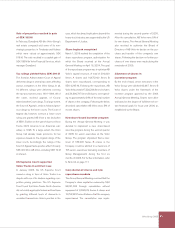Volvo 2005 Annual Report Download - page 42
Download and view the complete annual report
Please find page 42 of the 2005 Volvo annual report below. You can navigate through the pages in the report by either clicking on the pages listed below, or by using the keyword search tool below to find specific information within the annual report.
38 Volvo Group 2005
DME truck during the year, a prototype with
second-generation technology.
The Group is also conducting research in
the hybrid area, which can be considered a
competitive and promising solution for heavy
vehicles. During the year, Mack Trucks pro-
duced a prototype hybrid driveline. Earlier, the
Group has presented two concept vehicles,
which are hybrids based on a gas turbine with
integrated high-speed generator and on bat-
teries connected to an electrical motor for
emission-free driving in sensitive areas.
Environmentally adapted production
Environmental protection and responsible util-
ization of our shared natural resources are
obvious aspects of all production. The Volvo
Group places environmental challenges on all
its facilities. These challenges include guide-
lines for the utilization of chem-icals, energy
use, emissions into the air and water, waste
management, environmental organization and
improvement efforts. The fundamental prin-
ciple is that the facilities shall follow the very
strictest requirements, that is, either the Volvo
Group’s environment requirements or local
laws and regulations.
Since 1989, routine audits are conducted in
order to monitor environmental efforts. The
Volvo Group has insurance coverage for envir-
onmentally related damages to the immediate
surroundings, for example in the event of a
sudden emission.
All of Volvo Group’s production facilities
have the requisite environmental permits. In
Sweden, there are 16 facilities that require
permits. Those permits encompass waste,
noise and emissions into the air, ground and
water. One Swedish environmental permit is
subject to renewal in 2006.
During the year, AB Volvo decided to invest
SEK 650 M in a new topcoat paint shop at its
cab plant in Umeå, in northern Sweden. The
new paint shop will be the cleanest shop in the
world, with very low emission levels and a low
impact on the environment due to an invest-
ment in entirely new lacquering and paint
technol ogy. Total emission levels will be one
effect on fuel consumption. For example, the
same vehicle’s fuel consumption can vary by
as much as 20% between different drivers. In
some markets, the Volvo Group companies
offer driver training programs that cover both
fuel-efficient driving and safe driving.
Alternative drivelines and fuels
While the primary focus is on improving diesel
engines, the Volvo Group has made significant
strides in the area of alternative engine types
for fuels that can be produced from biomass
and thereby be carbon-dioxide neutral, includ-
ing biogas, rapeseed methyl ester (RME) and
synthetic diesel.
Today, the transport sec tor is almost entirely
dependent on oil. One of the fuel alternatives
being considered by the Volvo Group is di-
methylether (DME). The Volvo Group’s studies
show that DME has great long-term potential
as a competitive alternative. The argument for
DME is that it can be used in a converted die sel
engine, that it can be produced from renew-
able raw materials that do not add any extra
carbon dioxide into the atmosphere and that it
is currently the alternative fuel that has the
highest level of efficiency in total and among
the lowest level of nitrogen oxides and par-
ticulate emissions. Volvo Trucks presented a
Since 1996, emissions of nitrogen
oxides and particulates have
decreased by some 60%. In connec-
tion to the implementation of Tier 3,
Volvo CE introduced products
equipped with the new technology,
V-ACT (Volvo Advanced Combustion
Technology).
This is a technology to adjust the
burning in the combustion chamber
to achieve low emissions. By 2014,
emissions of both nitrogen oxides
and particulates are to be reduced
by another 90% compared to the
current Tier-3 level.
Tier 4B, 2014
Engine Power: 130-225 KW
Tier 4A, 2011
0.6
0.5
0.4
0.3
0.2
0.1
0
Particles, g/KWh
NOx, g/KWh
01234567889
Tier 1, 1996
Tier 2, 2002Tier 3, 2006
Emission legislation
for construction equipment
First carbon-dioxide-free
vehicle plant
The Volvo Group works actively to
reduce carbon-dioxide emission
levels from its facilities. The truck
facility in Tuve, Sweden, is to be the
first carbon-dioxide-free vehicle
plant in the world. Together with
Göteborg Energy, Volvo will build
wind power plants and a fuel facility
that will provide the factory with all
the energy it requires for produc-
tion.



